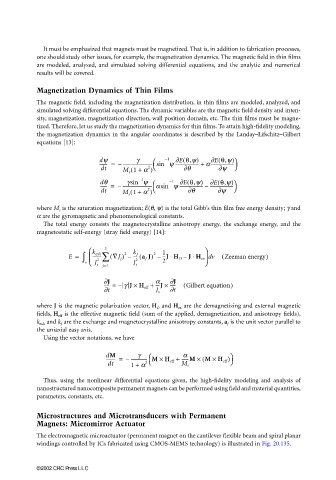Page 645 - The Mechatronics Handbook
P. 645
0066_Frame_C20.fm Page 115 Wednesday, January 9, 2002 1:46 PM
It must be emphasized that magnets must be magnetized. That is, in addition to fabrication processes,
one should study other issues, for example, the magnetization dynamics. The magnetic field in thin films
are modeled, analyzed, and simulated solving differential equations, and the analytic and numerical
results will be covered.
Magnetization Dynamics of Thin Films
The magnetic field, including the magnetization distribution, in thin films are modeled, analyzed, and
simulated solving differential equations. The dynamic variables are the magnetic field density and inten-
sity, magnetization, magnetization direction, wall position domain, etc. The thin films must be magne-
tized. Therefore, let us study the magnetization dynamics for thin films. To attain high-fidelity modeling,
the magnetization dynamics in the angular coordinates is described by the Landay–Lifschitz–Gilbert
equations [13]:
(
(
dy g – 1 ∂E θ,y) ∂E θ,y)
------- = – -------------------------- sin y --------------------- + a---------------------
2
dt M s 1 +( a ) ∂q ∂y
(
(
dq gsin – 1 y – 1 ∂E θ,y) ∂E θ,y)
------ = – -------------------------- asin y --------------------- – ---------------------
2
dt M s 1 +( a ) ∂q ∂y
where M s is the saturation magnetization; E(θ, ψ) is the total Gibb’s thin film free energy density; γ and
α are the gyromagnetic and phenomenological constants.
The total energy consists the magnetocrystalline anisotropy energy, the exchange energy, and the
magnetostatic self-energy (stray field energy) [14]:
2 ∑
⋅
2
2
E = ∫ k exh 3 ( ∇J j ) – ---- a J J( ) – 1 --JH D –⋅ JH ex vd ( Zeeman energy)
k J
--------
v 2 2
J s
j=1 J s
∂J a ∂J
----- = − g J × H eff + ---J × ----- ( Gilbert equation)
∂t J s ∂t
where J is the magnetic polarization vector, H D and H ex are the demagnetizing and external magnetic
fields, H eff is the effective magnetic field (sum of the applied, demagnetization, and anisotropy fields),
k exh and k J are the exchange and magnetocrystalline anisotropy constants, a J is the unit vector parallel to
the uniaxial easy axis.
Using the vector notations, we have
dM g a
-------- = – --------------- M × H eff + ------M × ( M × H eff )
2
dt 1 + a M s
Thus, using the nonlinear differential equations given, the high-fidelity modeling and analysis of
nanostructured nanocomposite permanent magnets can be performed using field and material quantities,
parameters, constants, etc.
Microstructures and Microtransducers with Permanent
Magnets: Micromirror Actuator
The electromagnetic microactuator (permanent magnet on the cantilever flexible beam and spiral planar
windings controlled by ICs fabricated using CMOS-MEMS technology) is illustrated in Fig. 20.135.
©2002 CRC Press LLC

